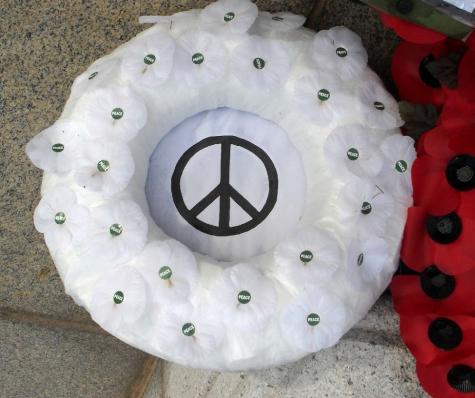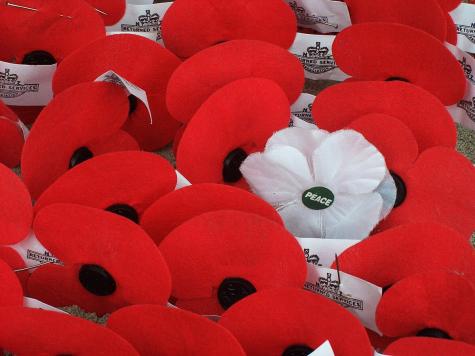The White Poppy

➡️ THE WHITE POPPY CAMPAIGN & Peace Pledge Union
Remembering All Victims of War & Promoting Peaceful Alternatives
The white poppy serves as a symbol of remembrance and peace, worn in the lead-up to Remembrance Day on 11 November, marking the anniversary of the end of the First World War.
As an alternative to the widely used red poppy, the white poppy honours all victims of war regardless of their stature or nationality. Often worn alongside the red poppy, which honours the British and Commonwealth armed forces who have lost their lives at war and also supports current armed forces.
First produced in 1933 by members of the Cooperative Women's Guild, the white poppy drew attention to the human cost of war and the urgency of building peace under the rallying cry 'Never again.'
The White Poppy campaign has grown significantly in popularity in recent years, as we continue on a war path on a planet experiencing the highest number of armed conflicts since 1945. White poppy ceremonies are springing up across the UK and have been seen on many high-profile politicians and MPs.
Jump straight to our resources on the ➡️ White Poppy Campaign
Explore our comprehensive guides on -
-
The Poppy Appeal
-
The British Military
By wearing a white poppy, we are showing respect for all of those killed, wounded (physically and emotionally), and those made homeless, sick, and starving because of war. It also honours the war resisters and conscientious objectors who refuse to fight and are killed or imprisoned for their values.
The White Poppy Campaign is supported by the Peace Pledge Union, the British branch of War Resisters' International. As one of the UK's oldest pacifist organisations, their mission is to resist everyday militarism, promote nonviolent solutions, and educate for peace. Their poppies are available to purchase online, and all profits go directly to promoting peaceful alternatives to war.
They argue that many of the traditional events and ceremonies around Remembrance Day exclude meaningful attempts to learn from the dire consequences of war and prevent them from happening in the first place. Remembrance Day overlooks the drivers of conflict, death, destruction and suffering.
The reckless trading of arms for endless profits, rampant military spending, dominant nationalist narratives, spiralling NATO budgets, rearmament pushes, and nuclear weapon expansion programmes all make the British government complicit in major ongoing and deadly wars around the world and the growing culture of militarism.

Three Symbols of the White Poppy
-
REMEMBRANCE - Honouring all victims of war, including both civilians and members of the armed forces from all nationalities. The White Poppy symbolises remembrance for those killed in wars happening today, as well as in the past, and the victims who have been treated as after-thoughts, such as refugees and victims of colonial conflicts.
-
CHALLENGING WAR & MILITARISM - War should never be glorified or celebrated. White poppies encourage us to question the normalisation and justification of war. War can never be justified, we must resist militarisation and tackle the roots causes of conflict.
-
COMMITMENT TO PEACE - We must seek nonviolent solutions to conflict in the first instance, every time. By drawing attention to the devastating human cost of war, white poppies highlight the urgency of our ongoing struggle for peace.
Politicalisation of the Poppy
In recent years, what was once a simple show of support has taken on a new meaning. Many examples of performative poppy wearing by high-profile politicians, news broadcasters, and public figures have distracted from the original message.
Prominent figures are being called out for either not wearing one or wearing the wrong colour. After the recent nationwide anti-immigration protests, some are wondering whether to wear the poppy at all in case it is misinterpreted.
In the last few months, Saint George's flag has been repeatedly used by right-wing extremist groups and in anti-immigration marches. The flag is not inherently racist, but its connotations with these narratives have made it synonymous with intimidation and hateful sentiments.
The white poppy offers an alternative, one whose message cannot be mistaken. This year, the leader of the Green Party, Zack Polanski, wore both. Former Green Party leader Carla Denyer, whilst laying a wreath of red and white poppies at Bristol's remembrance service, explained the significance - "red to help those who have been affected by war, and white to actively build peace as an alternative to war".

MPs from several parties, including Labour, the Greens, the Liberal Democrats and Plaid Cymru, have all worn white poppies over the years.
Potential controversy also arises with the Peace Pledge Union's stance, which actively supports a defunding of the British Armed Forces. The argument is that we are only able to enjoy safety because of the hard work and sacrafices of these forces who are on standby to go to war. If we defund them, we are left in a more vulnerable position.
The relatively new purple poppy is gaining popularity every year. Founded in 2026, Murphy's Army Purple Poppy Campaign is a tribute to animals' lives which have been lost in service, and to those who continue to serve us today. Their campaign raised awareness about the rightful recognition of the horses, dogs, and other animals who have died in service. They have raised over £200,000, which supports former service animals in their retirement, including those in the police, prison, fire, and border force services.
*****
While governments increasingly line the pockets of military contractors and weapons manufacturers and protect their own self-serving nationalist interests, the white poppy serves as a symbol of hope. It encourages us to stand up for peace and resist the war machine and its path of destruction.
Let us remember those who sacrificed their lives for our freedom, whilst also promoting a world without war. The White Poppy Campaign allows us to respect both the lives of the past, and those of future generations.
Author: Rachael Mellor, 13.11.25 licensed under CC BY-ND 4.0
For further reading on the White Poppy Campaign see below ⬇️
- WHITE Poppies for a Culture of Peace - PPU95480
- PPU Educational Material95486
- Google NEWS (UK)497493
- The trouble with white poppies (PPU)95517
- Red Poppy or White Poppy? The Remembrance Day Debate95493
- The White Poppy ! - YouTube95485
- Red Poppy - White Poppy95487
- White Poppies - Wikipedia95509
- Twitter - #WhitePoppy95510
- Twitter - #WhitePoppies95511
- Performative poppy wearing has turned toxic – should we be wearing white poppies instead? - Independent 11.11.25497661
- What does a white, black, and purple poppy mean? - Gazette 11.11.25497495
- What does a white, purple or blue poppy mean? Different colour poppies explained - Metro 11.11.25497494
- White poppy ceremonies held in memory of all victims of war, amid soaring casualties worldwide - Peace Pledge Union 10.11.25497658
- Tweet: This morning I laid a wreath of red and white poppies at Bristol’s #RemembranceSunday service. Every November, I choose to wear both a red and a white poppy: red to he…497660
- Growing call to recognise civilians on Remembrance Day, amidst record conflict deaths worldwide - Peace Pledge Union 09.11.25497659
- Dunkirk actor Sir Mark Rylance backs white poppy movement - Telegraph 01.11.25497496
- Tweet: Thank you so much to @carla_denyer, the co-leader of @TheGreenParty, for dashing over after the commemorations at the #Cenotaph to the National Alternative #Remembranc…439899
- White Poppy to remember All who have died as the Result of War - The Peace Party 09.11.24439908
- I wear a white poppy because Remembrance Day’s staged fervour does little to honour my grandad - Guardian 08.11.24439903
- Why do some people wear white, purple or black poppies on Remembrance Day? - Independent 07.11.24439906
- More students and teachers drawn to white poppy at a time of escalating conflict - PPU 01.11.24439904
- White poppy sales soar as students show solidarity with Gaza - The Telegraph 31.10.24439907
- Wear a white poppy - Stand up for peace in troubled times - PPU 30.10.24439905
- Surge in demand for white poppies amidst ceasefire protests - Peace Pledge Union 11.11.23382983
- Tweet: Breaking news: Surge in demand for #WhitePoppies amidst ceasefire protests. “The PPU has experienced an unprecedented rush of orders...” - @PPUtoday 11.11.23382988
- Tweet: The white poppy remembers those who died in conflict, but focuses on achieving peace and challenging the way we look at war. Some feel that the red poppy glorifies war…382989
- What do the different colour poppies mean? Meaning of red, purple, white and black symbol - inews 08.11.23382986
- Video: How to Attach Your White Poppy - Peace Pledge Union YouTube 08.11.22382981
- "Wear your white poppy and be ready to explain why." #NoWarNoWarming Tweet by @SecureScotland263331
- White poppy remembrance ceremonies to be held around Britain - Peace Pledge Union 11/19192933
- White Poppies (Song) - YouTube 10/1395516
- Remembrance Day: Bromley pacifists explain the white poppy wreath they have been laying at the war memorial for three decades 11/1395525
- White Poppies at Sheffield SU - YouTube 11/1295495
- What the White Poppy stands for - YouTube 11/1295488
- Legion sees red over white poppy campaign 11/1295535
- The White Poppy - Love in Action (Ottawa, 2011)95496
- The White Poppy - Ottawa (2010)95501
- The Cenotaph, Whitehall95559